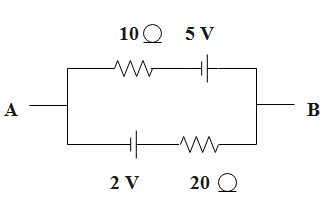
The current in the given circuit is

A. 0.3 amp
B. 0.4 amp
C. 0.1 amp
D. 0.2 amp

Answer
556.5k+ views
Hint: The given question is based on the concept of Kirchhoff’s voltage law. Using Kirchhoff’s voltage law formula we will solve this problem. As only one circuit is given, so only a single current flow is considered.
Formula used: \[V=IR\]
\[\sum{V}=0\]
Complete step by step answer:
The below equation represents the formula of Kirchhoff’s voltage law.
\[\sum{V}=0\]
Where the summation of voltages represents the number of voltage sources present in a circuit.
From the given circuit diagram, we have the data as follows.
The values of resistances = \[10\Omega ,20\Omega \]
The values of voltages = 2 V, 5 V
The formula that relates the current, voltage and the resistance is given as follows. This relation is defined by Ohm’s law.
\[V=IR\]
Where V is the voltage, I is the current and R is the resistance.
Let I be the current flowing through the circuit.
Now apply the KVL to the circuit given. So, we get,
\[10\times I-5+20I+2=0\]
The value of 5 V is taken to be negative, whereas, the value of the 20 V is taken to be positive, as we have considered the clockwise direction.
Now continue the further calculation.
\[\begin{align}
& 10I+20I=5-2 \\
& 30I=3 \\
\end{align}\]
Therefore, the value of the current is given as follows.
\[\begin{align}
& I=\dfrac{3}{30} \\
& I=0.1\,A \\
\end{align}\]
\[\therefore \] The value of the current through the circuit is 0.1 A.
So, the correct answer is “Option C”.
Note: This is a direct question. The formula used is the Ohm’s law formula. The units of the parameters should be known. In this question, the value of the current is asked, even, they can ask for either the value of resistance or the voltage by providing the values of the other two.
Formula used: \[V=IR\]
\[\sum{V}=0\]
Complete step by step answer:
The below equation represents the formula of Kirchhoff’s voltage law.
\[\sum{V}=0\]
Where the summation of voltages represents the number of voltage sources present in a circuit.
From the given circuit diagram, we have the data as follows.
The values of resistances = \[10\Omega ,20\Omega \]
The values of voltages = 2 V, 5 V
The formula that relates the current, voltage and the resistance is given as follows. This relation is defined by Ohm’s law.
\[V=IR\]
Where V is the voltage, I is the current and R is the resistance.
Let I be the current flowing through the circuit.
Now apply the KVL to the circuit given. So, we get,
\[10\times I-5+20I+2=0\]
The value of 5 V is taken to be negative, whereas, the value of the 20 V is taken to be positive, as we have considered the clockwise direction.
Now continue the further calculation.
\[\begin{align}
& 10I+20I=5-2 \\
& 30I=3 \\
\end{align}\]
Therefore, the value of the current is given as follows.
\[\begin{align}
& I=\dfrac{3}{30} \\
& I=0.1\,A \\
\end{align}\]
\[\therefore \] The value of the current through the circuit is 0.1 A.
So, the correct answer is “Option C”.
Note: This is a direct question. The formula used is the Ohm’s law formula. The units of the parameters should be known. In this question, the value of the current is asked, even, they can ask for either the value of resistance or the voltage by providing the values of the other two.
Recently Updated Pages
A man running at a speed 5 ms is viewed in the side class 12 physics CBSE

The number of solutions in x in 02pi for which sqrt class 12 maths CBSE

State and explain Hardy Weinbergs Principle class 12 biology CBSE

Write any two methods of preparation of phenol Give class 12 chemistry CBSE

Which of the following statements is wrong a Amnion class 12 biology CBSE

Differentiate between action potential and resting class 12 biology CBSE

Trending doubts
What are the major means of transport Explain each class 12 social science CBSE

Which are the Top 10 Largest Countries of the World?

Draw a labelled sketch of the human eye class 12 physics CBSE

Explain sex determination in humans with line diag class 12 biology CBSE

Explain sex determination in humans with the help of class 12 biology CBSE

Differentiate between homogeneous and heterogeneous class 12 chemistry CBSE




